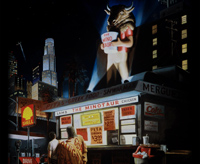 Threshold |
This year, the films of the fantastic at Indie Fest possessed a wide range of quality and ambition. But the best of them are cinematic treasures worth the effort of tracking down at other film festivals.
 Beach Party |
 Dante's Inferno |
A Victorian toy theatre plus some CGI and live-action footage are the media used to bring this Inferno to life. Mulroney and Cameron merely provide voiceovers. While Meredith gets points for novelty, his choice of medium somewhat detracts from the viewer's ability to empathize with Dante's ordeal.
The inventive political and cultural references peppering Dante's Inferno make Meredith's film an utter joy to watch. While familiar liberal and leftist bete noires such as the Haliburton Corporation get regularly skewered in the film, the manner of their skewering provide some entertaining surprises. Ronald Reagan gets condemned to Hell not for his political misdeeds, but because he consulted fortune-tellers.
 Dante's Inferno |
A step up in quality is the uneven Japanese horror film anthology Unholy Women. Its shock levels run the gamut from extremely unsettling to unfortunately tedious. Amemiya Keita's Rattle Rattle tells of Kanako, who is propelled by a freak accident into a Tokyo populated by ghosts and a malevolent red-robed pursuer. The roller coaster-style story barely bothers to develop Kanako as a character. What matters to the filmmaker is plunging his heroine into yet another adrenaline-pumping encounter. Despite the constant action, the viewer never feels as if Kanako's survival was ever in question. On the other hand, Rattle Rattle's attempts to resolve its mysteries neatly never slows its momentum. However, its final resolution ultimately comes across as a dramatic cheat.
Toyoshima Keisuke's The Inheritance fails to build menace or even successfully to layer atmosphere over a dull and familiar tale. Saeko and Michio's attempt to start a new life in the country home of Saeko's mother is threatened by a deadly legacy tied to the disappearance of Saeko's brother. The grounds of the grandmother's home never hint at the presence of a lurking evil, even with the appearance of a ghost boy. Nor does Michio come across as someone who is aware of an approaching doom, yet is helpless to stop its arrival. Despite working under the supervision of the creator of The Grudge, Toyoshima's effort elicits boredom not fear.
Suzuki Takuji's Steel presents an entertainingly macabre version of the male-female relations that turns out to be Unholy Women's highlight. Nowhere-bound Sekiguchi agrees to take Hagane, his boss' sister, out on a date. But the supposedly cute woman turns out to be a half sack-covered/half beautiful-legged creature whose contradictory behavior soon leads to major problems. Hagane's visual appearance provides a potent metaphor for male anxieties about female behavior. Her legs and bottom provide the sex appeal that initially attracts men's interest. Yet the woman's emotions remain a mystery thanks to the sack covering the upper half of her body. All Sekiguchi and the viewer ultimately have to rely on are Hagane's occasionally ambiguous actions. The film's naturalistic visual style and dark humor effectively heightens the bizarre nature of Sekiguchi's predicament.
Jonny Gillette & Kevin Wheatley's apparently visually messy The Beach Party At The Threshold Of Hell conceals a hilariously jaundiced look at the creation of history. This post-nuclear holocaust tale recounts Tex Kennedy's late 21st century campaign through a seriously devastated United States to install Benjamin Remington as the new King of America. Standing in Kennedy's path to glory are the psychotic Mr. Jackle, a giant sea serpent, and Yorick, a probable agent of the Devil.
Gillette & Wheatley's film constantly forces the viewer to question the official version of late 21st century history. It provides contradictory and illogical elements that make no fundamental or even literal sense. For example, how can the Gamma radio tower still have working radio broadcast equipment twenty years after the bombs dropped? If viewers are not sharp enough to get the film's point, Cannibal Sue's putdown of the stories about her ferocious strength clues viewers in not to take the movie's depicted events or oral history as gospel. Then again, the film carefully avoids revealing the truth about Sue and her fighting prowess.
The Beach Party... also indicts the gullibility attached to believing in the great man theory of history. Tex Kennedy may be revered as one of the founders of New America, yet the words he offers to inspire the few Americans he meets are emptily optimistic platitudes. These statements of hope are even less persuasive given that the man speaking those words is unshaven and wearing a badly stained power suit. Traditional historical documentaries try to build reverence in the audience for the events depicted. The Beach Party...'s title sounds more akin to an exploitation film than an account to be worshipped. The film's abrupt visual switches from over-exposed daylight footage to cel animation give this future historical account an oddly joking nature. But the presence of a robot with a five o'clock shadow and a drinking problem should have tipped viewers off that this film should not be taken seriously or literally. In short, if the late Douglas Adams had decided to do a future history with a touch of Grand Guignol, the result might have been The Beach Party...
The Beach Party... has played several film festivals before Indie Fest to great acclaim. Yet travels on the film festival circuit do not guarantee films such as The Beach Party... and Dante's Inferno will get commercial distribution. Does this mean that checking out the film festival circuit is a waste of time? No. It just means that checking out films of the fantastic at events such as Indie Fest shows one's dedication to finding a more interesting alternative to the Sci-Fi Channel's same-old same-old.
Peter Wong is a freelance reviewer of films and graphic novels whose reviews have appeared in venues as varied as "Emerald City," "Onomatopoeia," and "The Northwest Asian Weekly." In his off hours, he can be frequently found checking out the latest offerings at one of the small independent movie theatres or film festivals that are based in San Francisco.

